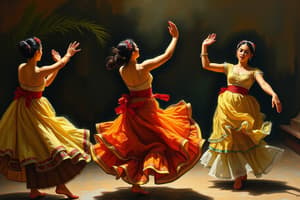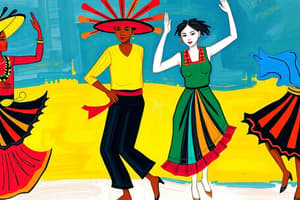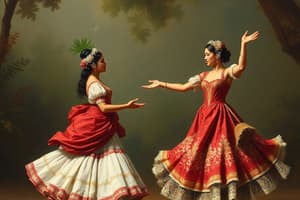Podcast
Questions and Answers
What is a common feature of Philippine folk dances regarding the positioning of dancers?
What is a common feature of Philippine folk dances regarding the positioning of dancers?
- Dancers frequently touch each other.
- Dancers are typically in a line formation.
- Dancers stand apart from one another. (correct)
- Dancers form tightly-knit circles.
Which statement accurately describes a characteristic of Philippine folk dances?
Which statement accurately describes a characteristic of Philippine folk dances?
- They always involve complex choreography.
- Dancers prefer to perform solo.
- Hand movements play a significant role. (correct)
- They feature extensive physical interactions among dancers.
What distinguishes dances from lowland areas in the Philippines compared to upland dances?
What distinguishes dances from lowland areas in the Philippines compared to upland dances?
- Lowland dances are purely traditional.
- They do not involve any hand movements.
- They have more foreign elements. (correct)
- They are performed in smaller groups.
Which type of dances is typically found among non-Christian tribes in the Philippines?
Which type of dances is typically found among non-Christian tribes in the Philippines?
What does the 'saludo' signify in Philippine folk dances?
What does the 'saludo' signify in Philippine folk dances?
Flashcards
Philippine Folk Dance Characteristics
Philippine Folk Dance Characteristics
Philippine folk dances are typically performed by individuals or couples, with minimal physical contact.
Formation in Folk Dances
Formation in Folk Dances
Many Philippine folk dances utilize long formations.
Saludo in Folk Dances
Saludo in Folk Dances
Most Philippine folk dances start and end with a 'saludo', a traditional greeting.
Hand Movements in Dance
Hand Movements in Dance
Signup and view all the flashcards
Lowland vs. Upland Dances
Lowland vs. Upland Dances
Signup and view all the flashcards
Study Notes
Philippine Folk Dance Characteristics
- Dancers generally stand apart, minimizing physical contact.
- Many dances are performed in pairs or couples.
- Hand movements are integral to the dances.
- Formations are often long.
- Most dances begin and end with a "saludo" (greeting).
- Lowland dances often exhibit more foreign influences compared to upland dances.
- Non-Christian tribes have war dances.
- The style is traditional and expressive.
- Simple, basic rhythms are dominant and define the movements.
Studying That Suits You
Use AI to generate personalized quizzes and flashcards to suit your learning preferences.




